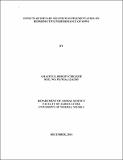UNNSpace Repository
Effects of Dietary Selenium Supplementation on Reproductive Performance of Sows
JavaScript is disabled for your browser. Some features of this site may not work without it.
| dc.contributor.author | Amaefule, Bright Chigozie
|
|
| dc.date.accessioned | 2017-04-21T09:08:22Z | |
| dc.date.available | 2017-04-21T09:08:22Z | |
| dc.date.issued | 2017-04-21 | |
| dc.identifier.uri | http://hdl.handle.net/123456789/4463 | |
| dc.description.abstract | This study was conducted to investigate the effect of dietary selenium (se) supplementation on the reproductive performance of sows, preweaning growth performance of their piglets, haematological and antioxidant status of pigs. Twelve (12) crossbred sows (Landrace × Large White) aged 1-2 years with an average body weight (BW) of 56.1 ± 5kg were randomly allotted to four treatment groups of three sows per treatment in a completely randomised design (CRD). The treatment groups comprised T0 (no Se supplementation), and T1, T2, T3 administered with 0.30 mg/Kg selenium‐methionine during second trimester of gestation, third trimester of gestation and lactation respectively. Selenium supplementation significantly (P<0.05) improved reproductive efficiency as measured by larger litter size (T0; 5.67 ± 0.33, T1; 6.00 ± 92.47, T2; 7.66 ± 1.20, T3; 8.33 ± 8.33) reduced mortality,( T0; 2.33 ± 0.33%, T1; 1.00 ± 0.49%, T2; 0.66 ± 0.33%, T3; 0.47 ± 3.05%), and increased litter weight at weaning (T0; 5.07 ± 5.92 kg, T1; 5.79 ± 0.02kg, T2; 5.76 ± 2.64kg, T3; 5.93 ± 1.85kg), in the Selenium treated groups when compared to the control group. Haematological parameters were not significant (P>0.05) among treatments during the second trimester of gestation. However, Se supplementation significantly (P<0.05) increased Pack Cell Volume (PCV) (T0; 32.50 ± 0.25%, T1; 38.50 ± 0.08%, T2; 37.00 ± 1.00%, T3; 34.50 ± 0.50%) and Red Blood Cell (RBC) (T0; 131.50 ± 28.5, T1; 185.0 ± 35.0, T2; 177.5 ± 32.5, T3; 210.0 ± 20.0) during the third trimester and Red Blood Cell (RBC) (T0; 108.0 ± 2.00, T1; 165.0± 15.0, T2; 175.0 ± 5.00, T3; 165.0± 5.00) and White Blood Cell (WBC) (T0; 22.07±0.44, T1; 11.20±0.80, T2; 9.00± 1.00, T3; 10.00±3.60) during lactation. All Se supplemented groups showed significantly increased plasma Selenium concentration in all stages compared with the control. Dietary selenium supplementation significantly increased plasma Glutathione –S- Reductase, Glutathione peroxidase (GSH-Px) activity during lactation (T3) and significantly (P<0.05) decreased plasma Malondialdehyde (MDA) (T0; 3.76 ± 1.74, T1; 0.12 ± 0.03, T2; 0.11±0.35, T3; 4.36 ± 0.62), (T0; 7.26 ± 0.08, T1; 3.60 ± 0.22, T2; 3.70 ± 0.27, T3; 2.27 ± 0.11),content in the third tremester of gestation and Lactation respectively. Superoxide Dismutase (SOD) and catalase activity in all treatment groups was significantly (P<0.05) different compared to the control. From these results, it was concluded that dietary selenium supplementation increased reproductive efficiency and enhanced haematological and serum anti-oxidant enzyme activities of pigs especially during gestation and lactation. | en_US |
| dc.language.iso | en | en_US |
| dc.subject | Sow Reproduction | en_US |
| dc.subject | Weaning Piglets | en_US |
| dc.subject | Selenium Supplements | en_US |
| dc.subject | Sow Diets | en_US |
| dc.title | Effects of Dietary Selenium Supplementation on Reproductive Performance of Sows | en_US |
| dc.type | Thesis | en_US |
